Lexus LS600h L Review
Lexus LS600h L
How much in-car technology does £80,000 buy you? Jeremy gets behind the wheel of a Lexus LS600h L to find out.
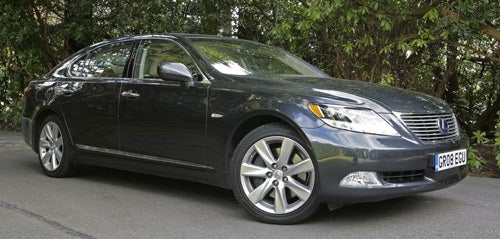
Verdict
If Lexus is synonymous with a very particular brand of opulent techno-luxury, the LS600h L is surely the distillation of the very finest mechanical wizardry and in-car comfort the Japanese car maker has to offer. In no particular order, this five-metre uber-saloon’s edited highlights include multiple radar and infra-red detection systems, driver monitoring, pre-crash technology including assisted steering and brakes, intelligent cruise control and self-parking. That’s right, folks. This car can drive itself, at least partially.
Of course, as the ‘h’ variant of the flagship LS range, it’s more than just the closest thing currently available to an automotive robot. It also sports a hybrid powertrain, combining an impossibly refined V8 engine with an electric motor. This translates into what Lexus describes as the performance of a 6.0L V12 engine with better-than 5.0L V8 efficiency. So, say what you want about the environmental credentials of a two-tonne limousine with Porsche Boxster-bashing performance. There’s no doubting hybrid drivetrains are set to become increasingly important over the next decade.
Along with the epic drivetrain and aforementioned panoply of driver aids and active safety features, the LS also packs an infotainment system with a monster specification. Then there’s the comprehensive comfort and luxury feature set. Everything is electric, from the soft-closing doors, the remote control bootlid and the ludicrously sumptuous, leather-clad rear ‘ottoman’ throne that literally massages its occupant.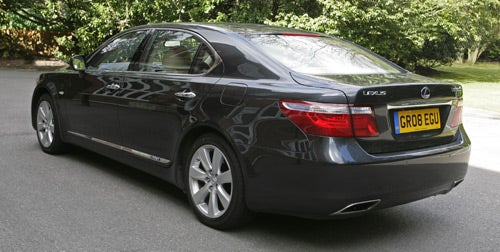
But despite its many advanced, even futuristic features, this big Lexus is also something of a dinosaur. We’ll come to the specifics momentarily. Suffice to say for now, various aftermarket devices can be bought for £200 or less that will endow any car with significantly more power and features in areas such as media playback and GPS navigation than this mighty, £80,000 mobile techfest can muster.
The centrepiece of the 600h’s interior, at least as far as front-seat occupants are concerned, is undoubtedly the infotainment system. Key components include the dash-mounted 8in touchscreen, Bluetooth, voice command and steering wheel controls.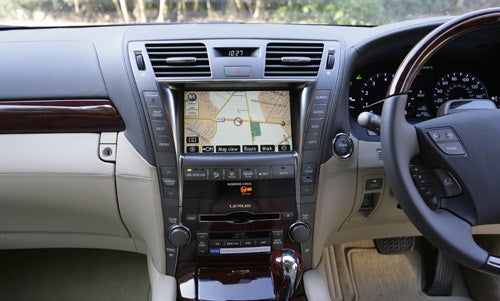
In terms of the overall human-machine interface, it’s a largely traditional architecture. Unlike BMW’s iDrive or Audi’s MMI, therefore, Lexus has made absolutely no attempt to consolidate a wide range of functions into a single, multi-function puck or joystick controller. Instead, the large touchscreen is surrounded by old school shortcut buttons providing instant access to commonly used features including navigation, climate and audio.
The immediate effect of this is to make the Lexus a fairly friendly and intuitive machine for first time users. Anyone with a passing familiarity with typical in-car systems will be up and running rapidly. In other words, many functions and features are accessible enough to save you the hassle of referring to the encyclopaedic tomes that are the 600h’s manuals.
By most metrics, Lexus’ “Intuitive Navigation” technology is thoroughly conventional. At its core is GPS technology augmented by the UK’s radio-based RDS-TMC traffic information system. On paper, that makes it significantly less powerful and sophisticated than the best aftermarket navigation systems. It conspicuously lacks, for instance, the detailed traffic data provided by TomTom HD Traffic or any live services beyond the relatively rudimentary information delivered by RDS-TMC. Forget weather updates, Google Local Search or anything that requires an Internet connection. The 600h doesn’t have one.
Likewise, it’s not as effective as the best aftermarket systems when it comes to providing alternative routes based on either live or historical traffic data or estimates of delay durations. For the record, it’s also worth noting that the system’s postcode input is limited to five digits. It’s not a major drawback, but again it does expose shortcomings compared to the best aftermarket systems. As for the Point of Interest (POI) database, well, much like those in other built-in sat-nav systems, it’s hardly comprehensive and probably of marginal utility beyond locating service stations or a hotel in an emergency.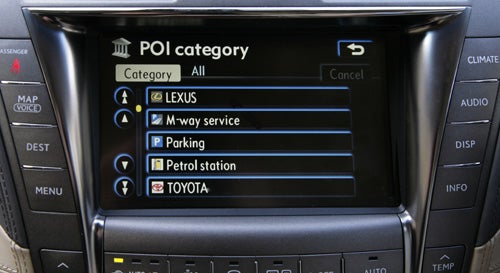
However, where Intuitive Navigation does score points is through sheer polish and ease of use. For starters, the 8in touchscreen is vivid and boasts excellent viewing angles. It’s also extremely accurate. Rarely must you take a second stab at the screen when inputting commands or text. Just as good is the quality of the graphical interface it displays. Mapping data is rendered top-down and 2D with two colour schemes, optimised for day and night time use respectively. Superficially, that might sound old hat in the context of the latest 3D navigation systems. However, most 3D systems are frankly a bit of a ruse, more 2.5D than true 3D. In practice, Lexus’ 2D maps are far slicker to look at than the likes of, say, the jagged pseudo-3D interface of a standard TomTom.
More importantly, they’re clear and easy to follow. Thanks to the healthy 8in diagonal of the screen, the dual-map function combining large-scale and small-scale views simultaneously also works extremely well. The same can be said of the voice guidance notes. They’re clear, well paced and give plenty of warning before junctions and exits. The system also deserves points for its speed and responsiveness. As a fully integrated system, it’s always on in the background and therefore aware of the location of the car. During our week with the LS, it didn’t put a foot wrong, never got confused about the car’s location or sat there waiting to acquire satellite signals. Overall, it’s an intuitive, stress-free and pleasant system to use.
There are, however, a few niggles. For starters, the voice command interface is extremely limited. Destinations must be pre-programmed into one of five memory slots, which can then be vocally requested by number. This is a particularly strange limitation given that the physically identical variant of the LS sold in the North American market supports full address input via speech recognition.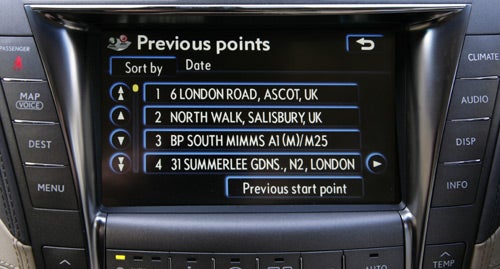
With that in mind, we also feel Lexus has gone overboard with the safety-related restrictions with which it has saddled the navigation system. The vast majority of options are locked out if the car is in motion. Only the five pre-programmed destinations can be accessed. Granted, it’s clearly undesirable from a safety perspective to have drivers wrestling with complex information systems while on the move. But the downside is that front seat passengers are also locked out. In short, if you want to input a new destination or select one from the recent destination list using the touchscreen interface, even from the passenger seat, you must bring the vehicle to a complete halt. 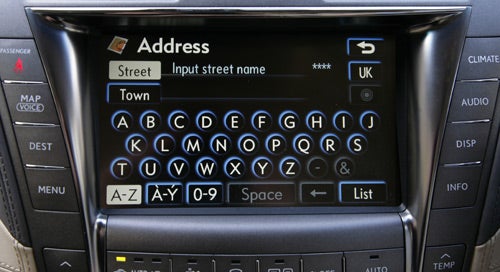
On a final note, we are obliged to give the heads up regarding the navigation system’s DVD-based underpinnings. That makes map updates more complex and expensive to perform because, typically, partial dash disassembly is required in order to swap the disk over. In short, it’s distinctly undesirable compared to a hard drive based system.
State-of-the-art sound systems have been part of the core Lexus remit since Toyota launched its luxury brand back in 1989. So, it’s no surprise to find the 600h packs a veritably thumping Mark Levinson stereo. Lexus puts heavyweight research and development into tuning its cars for optimal acoustics. For the most part, it really pays off. With no less than 19 speakers located throughout the cabin, there is monumental heft across the dynamic range without so much as a single rattle or squeak, even set to full. Windows down, this car is capable of treating other road users to truly obnoxious sound levels.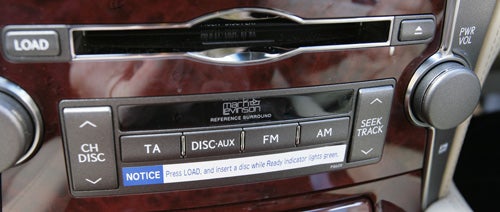
Of course, when it comes to audio quality, there’s no such thing as perfection. Audiophiles of a pedantic hue will note that the system’s overall output isn’t quite the sum of its parts. The upper reaches of the high range suffer slightly from that characteristic brightness that marks a system trying too hard to impress with showbiz moves, while bass extension majors on sheer thump rather than subtlety. Overall, it’s ever so slightly disjointed. But again, that’s the pedant in us talking. By any sane measure, the stereo simply rocks in terms of both sound quality and quantity.
That’s the good news. The bad is that when it comes to the latest digital media and file formats, the Mark Levinson kit is rather antediluvian. The dash mounted six-disc optical drive supports conventional audio CDS, video DVDs and playback of MP3 and WMA files stored on CDs. But that’s as far as it goes. There is no USB port. The only option for connecting personal media players such as iPods is the aux-in 3.5mm jack located in the front armrest. What makes this all the more peculiar is that, again, the US market LS is significantly better specified. American buyers enjoy a hard-drive based system capable of ripping and tagging RedBook CDs, for instance. Admittedly, even the US market setup has shortcomings. But it’s still a clear cut above what UK customers enjoy.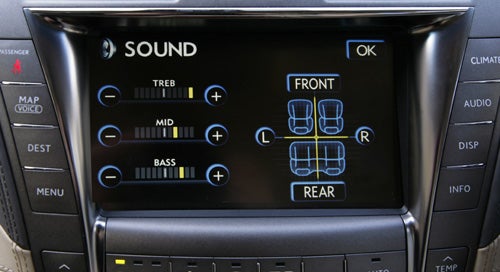
That, however, is not quite the end of the story. Lexus was good enough to supply us with the bad boy of the LS range, the long wheelbase ‘L’ model. We therefore had the pleasure of sampling the secondary entertainment system located in the rear of the car. This comprises a 9in LCD display that unfolds from the roof at the touch of a button, a control console situated between the two rear passengers, a dedicated CD/DVD changer, again located between the rear seats, and two pairs of wireless headphones.
The system is partially integrated with the main dashboard entertainment rig, allowing rear passengers to control volume, track selection and so forth of both front and rear sound systems as well as view progress and location on the sat-nav interface (no interaction is possible) via the rear screen. However, the rear CD/DVD changer is just that. It only supports conventional audio CDs and video DVDs. DivX, MPEG4, you name it, it’s not supported. Nor are Blu-ray discs.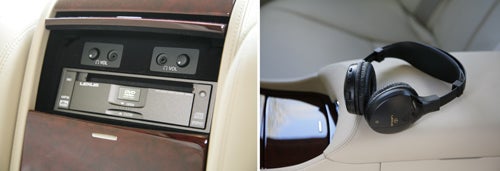
Granted, it’s arguable whether the captains of industry at whom this car is aimed are likely to care about the likes of DivX playback. You might also consider HD video support on a 9in display somewhat academic. And yet the overall low-tech vibe remains strangely out of keeping for such an otherwise advanced, not to mention expensive, vehicle.
A fully featured, handsfree Bluetooth telephony interface is what you would expect from a car of this stature. And that’s nearly what you get. In practice, the pairing process with a mobile handset is fairly straightforward, even if the Bluetooth options are buried rather deep in the system’s menu. As ever, results will vary according to the make and model of your phone.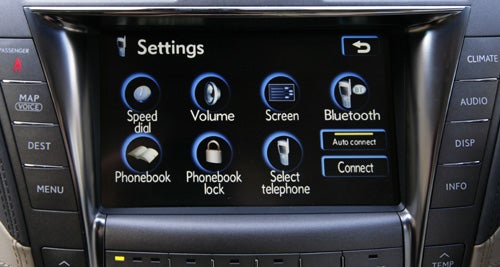
We experienced a number of compatibility issues, both minor and major, with an LG Viewty handset including problems making outgoing calls. More disappointing is the fact that, yet again, telephony is an area where the British LS draws a short straw compared with its North American cousin. Both telephone number input and contact name recognition are off the voice command menu. Only the memory presets can be summoned by speech alone.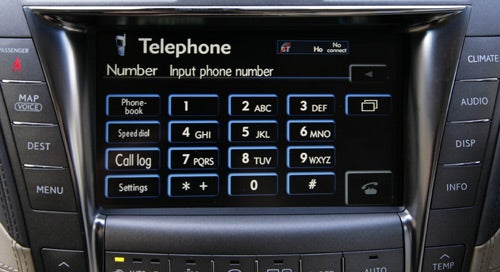
Bluetooth aside, the LS is short on networking support, Internet browsing or anything of that nature. High rollers in the back must whip out their own 3G devices if they want to keep in touch with the outside world. Admittedly, in-car Internet access is only just beginning to reach the market. The LS has been on sale in the UK for over 18 months, probably making it one of the very last uber saloons to launch without some kind of Internet access. BMW, for example, is beginning to roll out its ConnectedDrive Internet access technology across its range, allowing full web browsing in some models including, crucially, the latest 7 series. Undoubtedly, lack of Internet connectivity will increasingly become a weak point for the LS, given its target market.
Comfort is what Lexus does best and the LS600h L is unquestionably the most salubrious member of its range. It’s literally rammed with luxury-oriented features including four-zone climate control, semi-aniline leather, scores of vents and diffusers throughout the cabin, LED lighting and, of course, electric everything. Indeed, it’s a measure of this car’s luxury prowess that features like keyless go are little more than a given.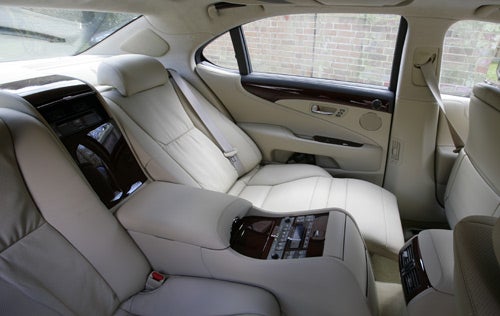
The ‘L’ model tested here also boasts a 120mm wheelbase extension, allowing more rear legroom as well as incorporating the optional Rear Seat Relaxation Pack. This equips the seat behind the front passenger with an airline-style reclining throne complete with an ‘ottoman’ foot and thigh rest. In fact, such is the priority placed upon this particular pew, it’s possible to fold the front passenger seat completely out of the way at the flick of a single switch. But the really snazzy bit is the multi-function massage feature which Lexus says faithfully replicates techniques including Shiatsu and acupressure. We can’t comment on how true that is. But we can say with confidence that 20 minutes of gentle pummelling courtesy of the leather recliner is an extremely pleasant experience.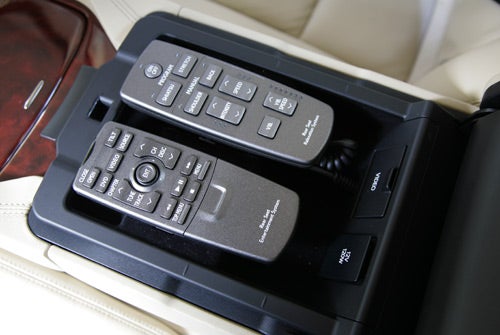
Needless to say, overall refinement is beyond reasonable reproach. Drivetrain noises are supremely well suppressed with just a hint of V8 rumble penetrating the cabin under hard acceleration. Likewise, the ride quality with the switchable air dampers set to comfort eschews any pretence at ‘Nurburgring’ handling antics in favour of pillowy, unruffled progress. Frankly, that’s as it should be in this sort of car. It’s unlikely that rear seat passengers will arrive at their destination after a long journey in a more serene physical and mental state in any other car.
The driver has it pretty good too, what with the triple-memory-slot power seat, the effortlessness of the drivetrain and the soothing tones of the navigation system. That said, the driver would be well advised to restrict use of the hit-and-miss voice command system to a minimum. We doubt whether it’s really any less effort or any safer to call out “lower temperature” than it is to hit a console button a couple of times. Especially if you have to shout it three times to get a response.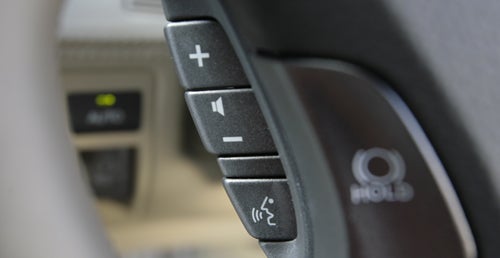
As for the overall fit and finish of the interior, it’s nothing short of exemplary. It’s also packed with numerous surprise and delight features such as sun blinds that slide effortlessly and silently out of both rear passenger doors and the rear window, and soft-closing doors. However, the cabin’s actual material quality and ambience are less consistent. The quality of the leather which clads most surfaces including the seats and dashboard is outstanding. But the infotainment console suffers from a faintly late 90s Japanese Hi-Fi vibe. Similarly, Lexus has also done a stand up job of making genuine wood veneer look and feel like polished plastic. Ultimately, the overwhelming air of density and robustness found in the best German cars simply isn’t present. 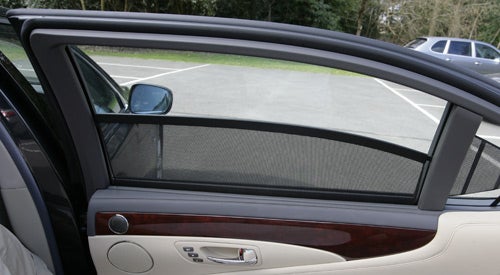
It’s at this stage that the LS takes a leap from the sublime, in the form of comfort, to an almost ridiculous display of technical prowess. From a review perspective, it actually presents something of a problem in that regard. Several of the driver aid systems are simply impractical or unsafe to test.
The pre-crash safety system is a case in point. Millimetre-wave radar front and rear, supplemented by infra-red cameras, is used to detect potential hazards. If the system judges that an accident is likely, the suspension and brakes are first primed, followed by emergency steering and braking assist if necessary. It’s not something that can be responsibly tested on public roads. The driver monitoring system also detects when the driver’s head is turned away from the road for too long and a collision is imminent. These capabilities are backed up by a number of further systems including wall-to-wall airbags and headrests that pop forward to prevent whiplash in the event of a rear-end impact. If you must have a crash, therefore, this car would be the one you’d want to be driving.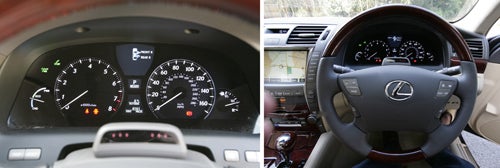
Fortunately, the LS also features a number of intriguing driver aids that very much can be evaluated. Perhaps the most famous of these is Park Assist which caters for both parallel and end-on parking bays. Taking the former as an example, the Park Assist routine begins by positioning the LS just beyond the target parking space. Once reverse has been selected, the main console touchscreen displays the rear camera view and the Park Assist menu. Using the touchscreen, the driver must then align a green graphical box over the target space. Next, the driver modulates speed with the brake pedal while the LS handles the steering duties in a single, reverse-in manoeuvre.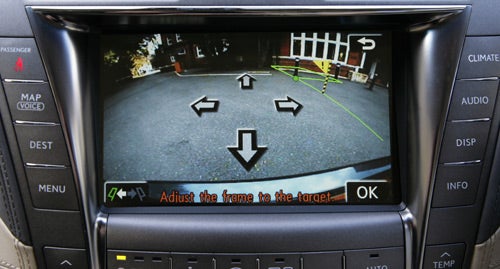
The question of how well this all works is complicated. But the short version is that it comes down to how precisely the driver has initially positioned the car itself on the road and then the green box on the screen. The system is very accurate at parking within the green box. But there’s something of a learning curve in judging how the location of the green box on the screen relates to reality. It’s all too easy, for instance, to set it too close to the side of the road and hence cause the car to inflict some nasty alloy-wheel kerbing upon itself. The whole process is also rather time consuming and therefore not awfully practical for use on busy thoroughfares.
More consistently of benefit is the intelligent cruise control. Courtesy of the radar systems, the LS is able to modulate speed and maintain one of three preset distances from the car in front. It can also detect lane incursions from other vehicles and take evasive action. It’s not a full stop-and-go system like the latest offered by some other car makers, including BMW. But it does work right down to extremely low speeds. In our experience, it does a very effective job of lightening the driver’s load in both congested motorway and urban driving environments, despite the fact that the system warns that it should only be enabled on multi-lane highways.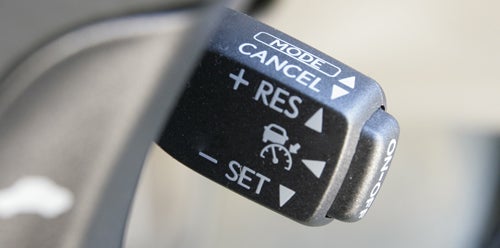
Another highlight, pun intended, involves the active LED dipped-beam headlights. The active moniker refers to their ability to swivel as the car is steered into corners, giving a better view of the road ahead. But their most impressive aspect is the sheer clarity and quality of the light produced by the LED lights. It makes the 600h’s own halogen high beams look like coal miner’s lamps. Frankly, even the xenon headlamps commonly used in upmarket cars seem ordinary by comparison.
The final part of this complex LS600h puzzle is the advanced drivetrain. Here at TrustedReviews, we’re not in the business of arguing the toss over the merits of V8 engines versus V12s. But the techie nature of this car’s hyrbid propulsion does merit an overview. The broad picture starts with a 5.0l petrol V8 cranking out 389bhp. This is supplemented by a 221bhp electric motor built into the combinated gearbox/differential casing. Together, these two power plants make 439bhp available to all four wheels. That’s correct, the sum is much less than the parts. However, the shortfall is by design – the idea is that the electric motor supplements both power and efficiency. Using both to the maximum simultaneously would compromise the latter.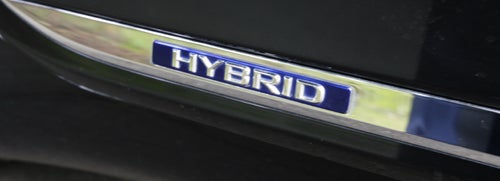
Electric power is stored in a 240-cell Ni-MH battery pack capable of 6.5 Ah and charged by both the V8 engine and regenerative braking. Now, we could tell you that the overall result is extremely impressive, delivering weighty, linear acceleration that feels much the same beyond 100mph as it does at 60mph. We could also regale you with the fun and frolics possible when using the drivetrain status monitor in the instrument binnacle to juggle power between the electric and petrol motors. But all of that is really beside the point. What really matters is how well the 600h delivers on its green credentials.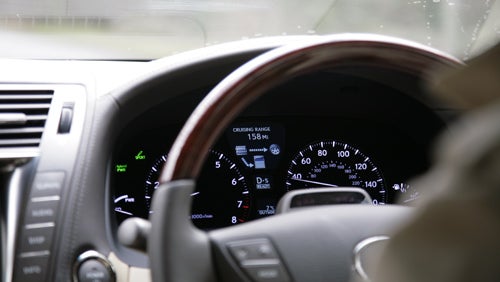
Officially, the 600h returns 30.4mpg on the combined cycle and is rated at 219g/km in terms of carbon emissions. That compares with 25.4mpg and 261g/km for its purely petrol-powered sibling, the LS460. During our time with the LS, it returned averages in the mid 20s, no doubt thanks to what we might euphemistically describe as enthusiastic driving. Still, that’s a pretty impressive achievement given that the LS460 sports a smaller, less powerful 4.6l V8.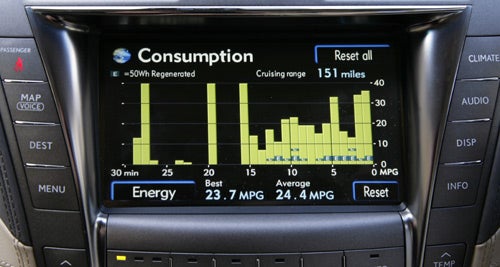
It must be said that the system is also extremely well integrated. Virtually zero driveline shunt is detectable as the petrol engine cuts in and out during stop start traffic. Our only significant criticism of this specific hybrid implementation is that the Ni-MH battery runs out of juice rather rapidly in heavy traffic. While we cannot be entirely sure, we suspect this may eventually have an impact on fuel efficiency.
Above all else, the LS600h L is an extremely complex machine. Attempting to compress its colossal array of features and capabilities into a handful of simple soundbites is therefore inevitably a little facile. And yet two overriding impressions emerge above all others. This is an immensely polished car, yet one that suffers from massive overkill. The first point reflects the fact that Lexus simply doesn’t do underdeveloped. Its engineers are renowned for the lengths taken to iron out any traces of harshness or imperfection. The result, from the near-silent hum of the V8 to the slick navigation interface, is a supremely refined and well finished vehicle.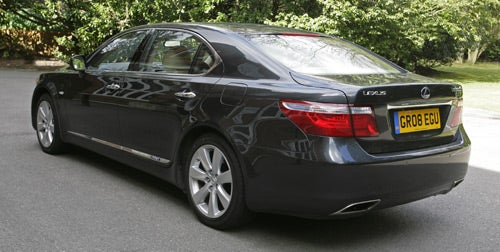
But in the context of its supposedly planet-friendly hybrid architecture, it’s also monstrously overwrought. There is little doubt, for instance, that a fairly modest diesel powerplant of perhaps 3.5l in capacity would deliver comparable fuel efficiency to the massively complex petrol-electric system Lexus has chosen, as well as all the performance this car needs in the real world. More to the point, a diesel engine as part of the hybrid system would deliver much better overall fuel consumption. In that sense, the environmentally friendly pretence is almost obscene. Hybrid drivetrain or no hybrid drivetrain, the 600h’s priorities lie in comfort and effortless performance, not efficiency.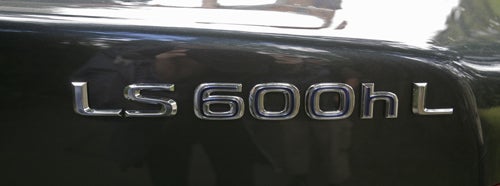
Making matters worse are the infotainment and communication systems. Despite numerous strengths, the fact that they feature a number of obvious shortcomings compared to not only widely available aftermarket technology and LS variants available in other markets but also systems from competing car makers doesn’t exactly sweeten the £80,000 deal the LS demands. In a way, the expertise and effort that Lexus has invested in this car make conventional criticism seem churlish. After all, in so many regards this vehicle is a glorious example of 21st century luxury motoring. But there’s no avoiding the final analysis. The LS600h L is also a strangely flawed machine.

